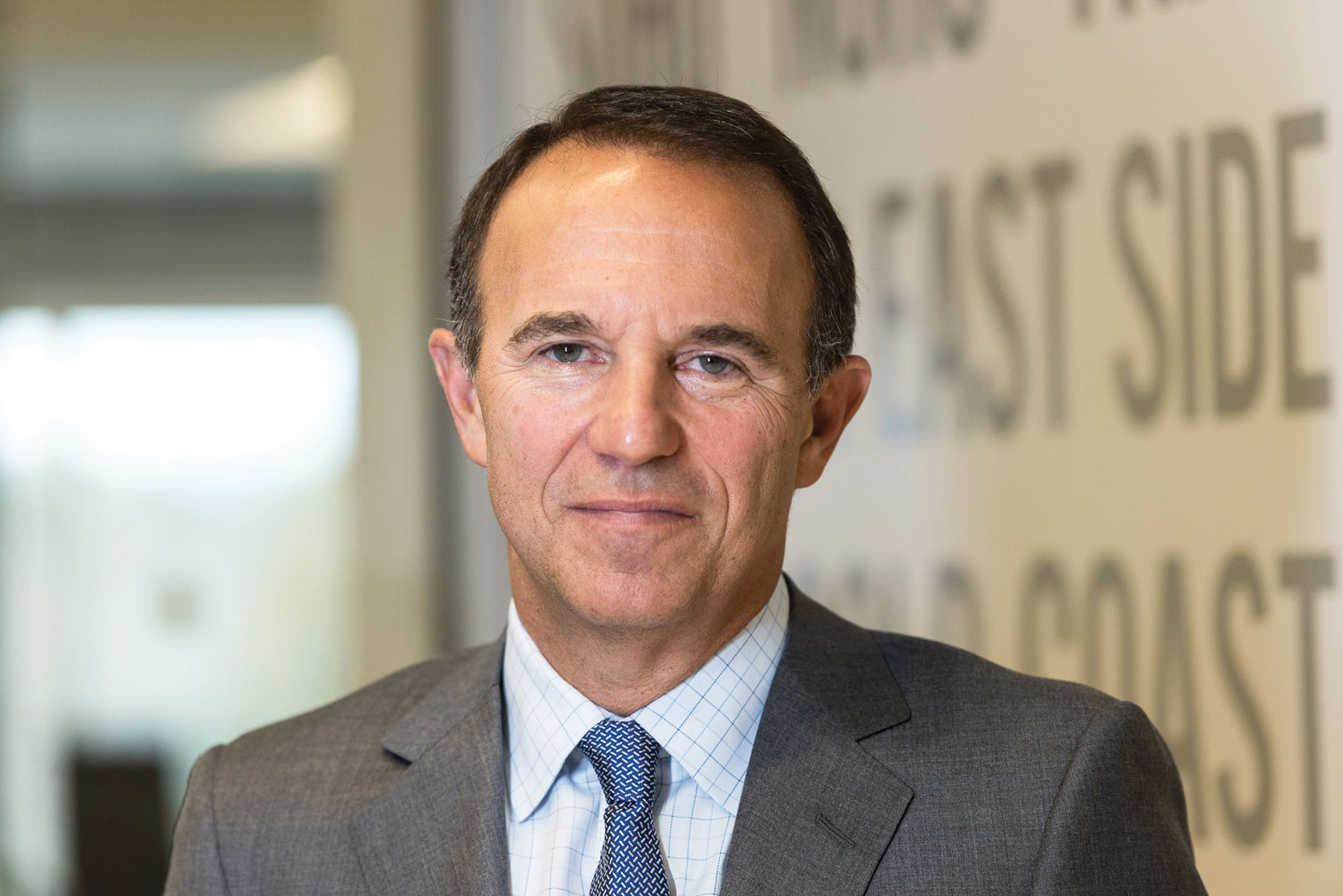In the waning months of 2017, economic forecasters saw plenty of reason for optimism about the year ahead.

In a November report, Kiplinger, for one, points to growing retail sales as a happy bellwether for brick-and-mortar stores. After rising by 1.5 percent in the first half of the year, U.S. retail sales (excluding e-commerce) accelerated by 2.6 percent in the second, the firm’s analysts reported. Bob Sheehan, vice president of research at Burlington, Mass.–based KeyPoint Partners, points to steadily improving comp-store sales at such tenants as Abercrombie & Fitch, Foot Locker and Gap. Their results in the latter half of the year, Sheehan notes in his firm’s November newsletter, were a nice contrast after a considerable stretch in which many chains’ comp-store sales had consistently declined even as Internet sales rose. “What may be even more promising, is the fact that all are mall-based retailers,” Sheehan writes.
Business investment also rebounded last year, growing by 4 percent, according to a 2018 economic forecast published by The Conference Board. The organization is predicting 2.5 percent growth in 2018. “This would represent the [U.S.] economy’s best 2-year run since 2005,” the analysts note in the forecast. Though they cite some potential drags — including the Fed’s raising interest rates slightly faster and the strengthening dollar’s potential impact on trade — their overall tone is sanguine. “With growth prospects strong for 2018, profits should grow robustly as well, rewarding those businesses that increase investment levels,” they write.
In tandem with rising household wealth and income in the U.S. and further gains in employment, Kiplinger’s analysts cite the prospect of ramped-up homebuilding and more construction in the year ahead. Meanwhile, a November report by Goldman Sachs Research focuses on strong prospects for the global economy overall. “For the first time since 2010, the world economy is outperforming most predictions, and we expect this strength to continue,” the report writers say. “Our global GDP forecast for 2018 is 4.0%, up from 3.7% in 2017 and meaningfully above consensus. The strength in global growth is broad-based across most advanced and emerging economies.”
Against this backdrop, SCT asked a host of experts to opine on the challenges and opportunities likely to shape the retail real estate landscape in 2018. At times, their comments focused on disruptive forces and new challenges. But they were just as likely to emphasize the importance of timeless fundamentals such as customer service, site selection and merchandising, or the enduring value of maintaining patience, discipline and an opportunistic mindset in the face of change.
Kenneth F. Bernstein, President and CEO, Acadia Realty Trust, ICSC Chairman 2017–’18

As chairman of ICSC, Kenneth F. Bernstein is certainly irked by headlines that fixate on the so-called “retail apocalypse.” But from a business perspective, the president and CEO of Acadia Realty Trust actually sees some upside to all of that supposed doom and gloom. “The headlines are grossly oversimplified, and they’re scaring too many capital providers to the sidelines,” he said. “But this also creates opportunities.”
Those opportunities are part of the reason Bernstein expects 2018 to be quite a busy year on the acquisition front for Acadia, which focuses on what he describes as a “buy, fix and sell” strategy. When lenders, investors and even some tenants are overly cautious, Acadia is happy to step in and buy assets that will pay off with time, such as stabilized shopping centers that have fallen into disfavor, Bernstein says. “As a result of the scary headlines in the media and other factors chasing away capital in the short run, we can buy them at an attractive yield, finance them intelligently and clip a very nice coupon,” Bernstein said.
The Rye, N.Y.–based REIT, which Bernstein co-founded in 1998, holds stakes in roughly 100 retail properties, valued at roughly $4 billion in the aggregate. These properties include retail corridors in such major markets as Chicago, New York City and San Francisco, as well as open-air centers in smaller cities around the country. Fund V, Acadia’s latest institutional fund for opportunistic and value-add investments, has about $1.5 billion of buying power.
Looking to the year ahead and beyond, Bernstein says he is optimistic about the prospects for retail real estate. “It is becoming clearer and clearer that bricks-and-mortar real estate — especially high-quality bricks-and-mortar real estate — not only is going to survive in the short run, but in the long run is the best pathway to profitability for retailers,” he said.
“Most retail real estate can either continue functioning as it always has, or else it can undergo successful adaptation at the hands of savvy owners and managers”
Not that this will be easy. In the months ahead, the challenge for many landlords will be to recognize opportunities amid widespread disruption and change, Bernstein says. “It is going to involve looking forward to figure out who the retailers of the future are going to be and how they’ll use bricks-and-mortar as part of their business,” he said. “We need to be prepared to embrace a host of changes that are occurring so that we can position our real estate to survive and thrive.”
Those changes include the trend among retailers to do more with less by incorporating omni-channel strategies and operating fewer stores with smaller footprints. This does alter the calculus for some properties, Bernstein notes. But even in these cases, opportunity often looms. At the end of 2016, Acadia spent $104 million to buy a four-story building on North Michigan Avenue along Chicago’s Magnificent Mile. The building had once housed a flagship men’s store for Saks Fifth Avenue. “We are going to do a gut and redevelopment of that,” Bernstein said. “It is an amazing location, with great long-term, intrinsic value — a significant, heavy-lifting, value-add opportunity — but the retailer had moved on.”
To Bernstein’s mind, most retail real estate can either continue functioning as it always has, or else it can undergo successful adaptation at the hands of savvy owners and managers. “If you pick the right locations and buy the right real estate,” he said, “and if you are patient and capitalize it correctly, the old rules still apply.”
Andrea Olshan, CEO, Olshan Properties

When landlords sign leases with trampoline park or indoor skydiving facilities, their goal is to drive traffic by bringing in novel activities that have nothing to do with shopping. But Andrea Olshan, CEO of Olshan Properties, strives to stay focused on retail fundamentals as well. “People can forget that ‘experience’ sometimes means just having a really positive shopping experience,” she said.
New York City–based Olshan Properties owns or manages about 10 million square feet of retail, including strip centers, malls, power centers, lifestyle centers and urban retail. Strong performers in the portfolio include HomeGoods, Marshalls, Nordstrom Rack and T.J.Maxx, Olshan says. By her reckoning, these chains have scored because they offer unpredictable merchandise lineups that surprise and excite shoppers. “We just toured our properties on Long Island,” she said. “Our T.J.Maxx, which is a huge store, was absolutely packed. It’s all because of the hunt.”
“These days you’ve got to bring your ‘A’ game and be collaborative”
For Olshan and her team, the tour highlighted the enduring importance of another retail fundamental: having the right store personnel. “When we visited our Long Island store for one particular chain, there was a lot of great product and it was laid out beautifully,” she said. “The manager there was excellent, and it was a super-positive experience.” Elsewhere in the portfolio, however, another store under the same nameplate happens to be struggling. “There the personnel are not very knowledgeable,” Olshan said. “The store is not buying a lot of great product, nor is that product being displayed in an organized fashion. The experience is very different.”
Now that so many landlords have jettisoned their underperforming properties to optimize performance postrecession, the goal should be to help tenants elevate their game on merchandising, marketing, customer service and the like, Olshan says. “Landlords now really need to be more vigilant and work on making their tenants successful,” she said. “If, in going into that store, you see that there’s an issue, you have to reach out to the company and make them aware of it. Otherwise, you’ll turn around one day and get a rent-reduction request.”
But rent reduction is of no use if a tenant is unaware of its own flaws. “Sometimes retailers will say: ‘We’re not doing well. OK, reduce our rent,’” Olshan said. “Instead, they need to think about what’s going on operationally. Try to give them that helping hand.” At regional malls, general managers have always stayed close to tenants in this way, but in the year ahead, even strip-center landlords should consider working more closely with individual stores to help them be their best, Olshan says. “These days you’ve got to bring your ‘A’ game and be collaborative,” she said. “It takes a team effort.”
Glenn Rufrano, CEO, VEREIT

Signing leases with urgent-care centers, offices, apartments, hotels and other nonretail uses can be a smart response to disruptive forces in the economy. At the same time, it can also create new challenges for landlords to confront, says Glenn Rufrano, CEO of VEREIT. “We define disrupters as something that, instead of being part of a cyclical trend, is part of a secular trend — a real change,” he said. “We have that in all forms of real estate. Each property type has its own disrupters.”
Given VEREIT’s diversified portfolio — 4,100 retail, restaurant, office and industrial single-tenant properties, valued at an aggregate $14.7 billion — Rufrano tracks trends in multiple property types. In 2018 and beyond, the CEO says, formerly retail-only companies will need to pay attention to disruptions across all of real estate as they diversify their properties. In some cases, that will involve bringing in outside experts who live and breathe nonretail asset classes. “Do what you know best,” Rufrano said. “Don’t get out of the realm of what you know and understand. Those disrupters out there, if you don’t understand them, will become a problem.”
“Each company should be creating a strategy so that the disrupters they face do not take away from what is a generally good economy”
What are some of the nonretail disrupters in play? In the U.S. office sector, the average amount of leased space per person continues to shrink as a result of open-floor plans, tele-working and other trends. “It used to be 250 square feet per person,” Rufrano said. “Now it is down to 150 square feet.” In hospitality and residential, disrupters like Airbnb are creating questions about long-term demand for space. In health care, meanwhile, uncertainty about government policy is a major potential disrupter. “If you are a health care REIT and you have any dependence on government payment, you just don’t know what will happen,” Rufrano said. Even the fast-growing industrial sector is subject to disruption, he says, because not every building is suited to the specific needs of companies like Amazon.com. “Unless it’s a functional building that can allow for conveyor belts going 30 or 35 feet and for rapid deployment of goods, then that building is obsolete,” Rufrano said.
Nonetheless, Rufrano says he is optimistic about the likely macroeconomic situation in 2018. Barring erosion of such metrics as GDP growth, inflation and the 10-year Treasury yield, he says, tenants will generally prosper. Fortunately, many landlords have already spent years making savvy adjustments, such as Simon’s sharp focus on top-tier malls. “Simon can say, ‘Look, we know there are online disrupters, but we have the best malls in the best locations, so we’ll be able to maintain our tenants and collect our rents,’” Rufrano said. “Each company should be creating a strategy so that the disrupters they face do not take away from what is a generally good economy. As we always say, if our tenants can pay their rents, we’ll be fine.”
Robert Spector, Co-Founder, RSi

Robert Spector, co-author of The Nordstrom Way to Customer Service Excellence, likes to give his university students the same basic project: Research a retailer that fizzled after hitting it big and explain what went wrong. “There used to be a discount department store in New York called E.J. Korvette,” he said. “In 1962, founder and CEO Eugene Ferkauf made the cover of Time. That’s how important they were. Why did they fail? They stopped adapting and innovating.”
As the students tend to discover, the same mistake underlies the fall of many once-great retail chains, says Spector, co-founder of Bellingham, Wash.–based consultancy RSi. “It could be Circuit City, Tower Records, Montgomery Ward or A&P, which was the Walmart and Google of its day,” he said. “In retail, if you are not changing and asking yourself ‘What’s next?’ then inevitably you are going to fail.”
To be sure, U.S. department stores continue to struggle with the rapid pace of change. But as Spector sees it, retailers of all stripes could benefit this year by emulating the adaptability of one of the department store sector’s leading lights: Nordstrom. Despite being nearly 117 years old, the Seattle-based chain is as nimble and channel-agnostic as any startup, Spector says. “They don’t have an online versus a brick-and-mortar customer,” he said. “Just a customer.” The author cites Nordstrom’s Reserve & Try service, launched in 2017, which lets customers reserve up to 10 items online and then try them on at the store. “There’s a dressing room set aside with those reserved items all ready for you,” he said. “If you make a purchase, it’s not an online sale or a brick-and-mortar sale. It’s just a sale.”
“ ‘Clerking’ is part of why so many retail stores are suffering”
Savvy approaches to integrating the in-store and online experiences will continue to be critical in 2018, Spector says. “They’re not silos — they should be part of an overall strategy,” he said. “Nordstrom is constantly asking: How do online and in-store work together?”
More broadly, retailers could learn a thing or two from Nordstrom’s widely admired focus on creating a culture of best-in-class customer service, Spector says. This includes thinking carefully about how to make things easier for shoppers, from returns that take one minute instead of 15, to the hyper-convenient holiday hours Nordstrom experimented with during the 2017 holiday season. “They’ve had buy online, pick up in-store for a while now,” Spector said. “But at 10 locations nationally in the week leading up to Christmas, Nordstrom is now offering curbside pickup 24 hours a day, seven days a week.”
Spector also lauds Nordstrom’s highly trained staff. Too many retailers, he says, fail to appreciate the steep costs associated with underpaid and poorly trained employees. “Nordstrom is not looking for clerks,” Spector said. “They’re looking for knowledgeable salespeople who can say, ‘You know, that men’s shirt that you bought — I’ve got some great ties to go with that, or a vest.’ Clerks, by contrast, just say: ‘That’s what you want? Here you go.’ They don’t know how to up-sell or cross-sell. ‘Clerking’ is part of why so many retail stores are suffering.”
Ron Wheeler, CEO, The Sembler Co.

Once a year Sembler Co. CEO Ron Wheeler heads to Gainesville, Fla., to meet with fellow members of the University of Florida real estate advisory board. Typically, he says, the board spends at least some of its time mulling the same basic question: When will interest rates spike and the good times come to an end? “Most people seem to believe there’s 24 months left in the cycle,” Wheeler said, “but the joke is that people have been saying that for the last three years.”
Wheeler has seen his share of downturns — including both the brutal real estate market of the late 1980s and early 1990s and, of course, the Great Recession. In fact, Sembler’s present-day focus on grocery-anchored shopping centers, many of them anchored by Publix Super Markets, is in part a safe-harbor response to the tumult of the last downturn. But as CEO of the 55-year-old company, Wheeler avoids making predictions about the market. “What I have tried to do instead is develop a business model that can handle and sustain a downturn and not see rapid fluctuations of things like staffing or underwriting,” he said.
“People ask where I think cap rates are going if interest rates go up, or they’ll want to know what spread on cap rates we develop to,” he said. “I don’t view it that way. As a matter of fact, I have kind of banned, internally, discussion of cap rates.”
Nor is Wheeler obsessed with tracking cap rates. “People ask where I think cap rates are going if interest rates go up, or they’ll want to know what spread on cap rates we develop to,” he said. “I don’t view it that way. As a matter of fact, I have kind of banned, internally, discussion of cap rates.”
And while public companies sometimes pursue extravagant growth, privately owned Sembler aims for returns that are in line with the risks inherent to particular deals, says Wheeler. That could mean building to an 8 percent return and selling at a 6 percent cap rate over a relatively short period of time, he says, but deals can just as easily require more patience, capital and a longer-term view. “If we build to an 8 percent return and we’re comfortable with that return and cap rates go to 10 percent, I’m not going to worry about it,” Wheeler said. “We’re just going to hold onto it and cash-flow it. We’ll have a lot of equity, be properly leveraged and wait until the market tells us that it makes sense to dispose of that asset. You won’t get hurt if you have patience and capital.”
In 2018, then, Wheeler aims to press ahead with this measured approach. Sembler’s pipeline includes new developments such as Amberly Village, a 72,000-square-foot, Publix-anchored center under construction in Cary, N.C., and also such redevelopments as the reboot of the 123,000-square-foot Disston Plaza, in St. Petersburg, Fla., where Sembler is tearing down a decades-old Publix and replacing it with a new one. The company will also continue acquiring grocery-anchored centers around the Southeast through a fund with Forge Capital Partners. But Sembler, which formed a partnership with mixed-use specialist Berkley Development last April, is also exploring alternative investments, including smaller power centers, urban redevelopment projects or the retail components of mostly residential projects, says Wheeler. “We’ve worked hard to find the right opportunities,” he said. “Few companies acquire centers but also have 55 years of development experience, so we also have skill sets that allow us to take advantage of those opportunities. It’s a good spot for us. We’re really positive.”
Rachel Elias Wein, President, WeinPlus

Lines are blurring across retail real estate, but not necessarily within companies themselves, says Rachel Elias Wein, president of WeinPlus, a St. Petersburg, Fla.–based strategy and management consultant firm. While traditional structures still work, Wein says, they can turn into silos if held too tightly. “Generally, I see companies that are set up by geographic and functional divisions,” she said. “For example, the Southeast team would have departments for operations, leasing and development. I like to see companies shuffle the deck a bit and move people around.”
The idea is not to blow up existing departments, Wein says, but to encourage cross-training. That might mean sending the Southeast team to tour properties in the Southwest, or periodically changing the responsibilities of people in operations, leasing or development to give them new experiences and perspectives. “When you go on a site visit, you can bring some different people than you would have brought the last time you were there,” she said. “Yes, you do want to retain consistency of view from visit to visit, but you also want fresh perspectives. The key is to really take the opportunity to listen to those who are closest to those assets. Often, they’re the ones who really know what needs to happen.”
With so much disruption afoot, companies stand to benefit by encouraging employees to embrace change and step out of their comfort zones, says Wein. After all, the market might force them to do that anyway. “If all of the aspects of our business could just get 1 percent better, the compounding effect would be astronomical,” she said. “Moving people around, encouraging them to think differently and push the envelope, is helpful. Stretching your mind is the same as stretching your body. When you get up and stretch, it’s good for you.”
By Joel Groover
Contributor, Commerce + Communities Today


